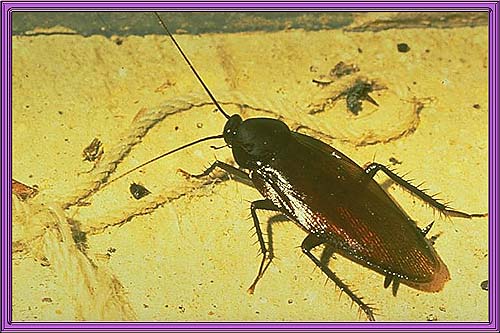
Periplaneta fuliginosa
Smokey Brown Cockroach
The smokey brown cockroach is a relative of the american cockroach and resembles it in shape and size. These cockroaches are more common in the southern United States, but we do get some immigrants mostly coming in on plant material and fruit etc.These beast are a little over 1inch long, and both sexes have wings that are longer than the abdomen. Their very dark mahogany colour is striking ; no light markings appear on the pronotum or wings. Nymphs like adults are also dark brown. The antennal tips of young nymphs are white, and the base segments of the older nymphs antennae are white.
Life Cycle: The egg capsule (oothecae) of the smokey brown cockroach is large and brown. The female usually glues the oothecae to objects in the harbourage. The oothecae holds an average of 17 eggs, but there have been cases of them holding 24 - 26, but this is not common. The Nymphs take between 6 - 12 months to develop, those that are nymphs in the summer will over-winter. The adults live for 6-12 months during which time the female will produce about 17 oothecae.
Habitat: Smokey brown cockroaches are suceptible to losing moisture through their cuticle, and so are usually found in damp, dark and poorly ventilated environments. They rarely infest the dwelling part of buildings, and are instead found in sheds, wall and roof spaces, sub-floors, mulched areas, and in and around grease traps and drains. They prefer food of a plant origin and are therefore often a pest in greenhouses, nurseries and gardens. They can fly short distances in warm weather and are often attracted to lights at night. In the U.S. southern states, Texas, California this cockroach is a common pest; living in gutters, eaves of the roof, under shingles and finding their way into attics.
Treatment: Normal application of dusts and sprays (preferably micro-encapsulated) into harbourages is important as this cockroach spends its time in outside areas hence this presents a risk to non-target species.